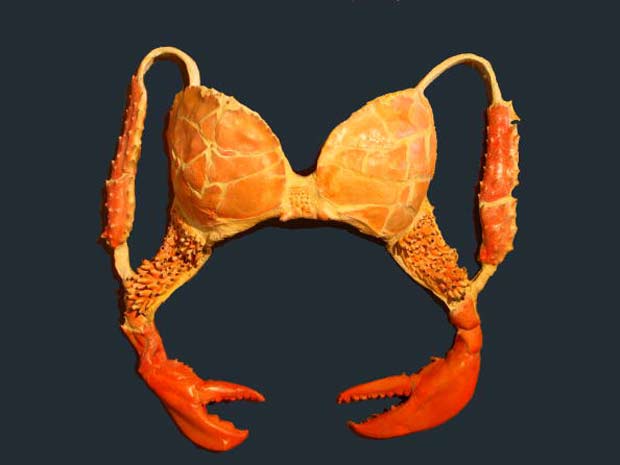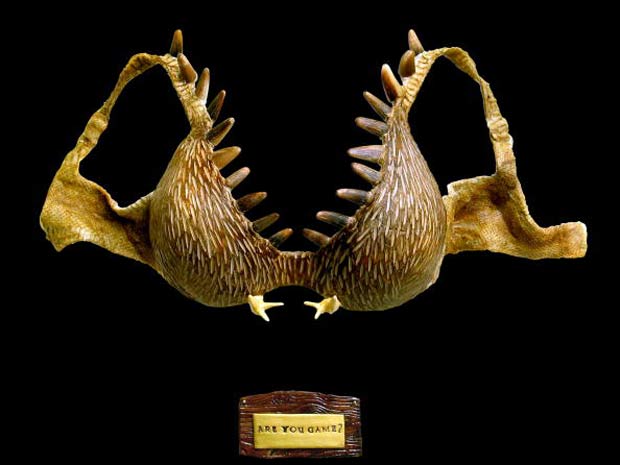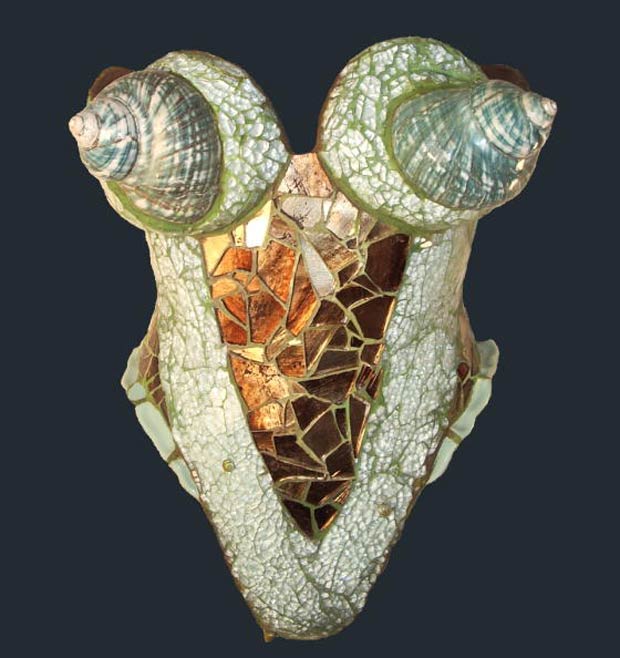Bioluminescent Mushroom
(Some fruiting bodies of Mycena luxaeterna growing on a rotten branch. © Cassius V. Stevani/IQ-USP, Brazil)
Name: Mycena luxaeterna
Common Name: Eternal light mushroom
Family: Mycenaceae
How it made the Top 10: This new species, collected
from some of the last remaining Atlantic forest habitat near São Paulo,
Brazil, emits very bright yellowish green light 24 hours per day from
its gel-covered stems. DNA sequences of this species
(from 5 gene
regions) are helping us to understand the origin and evolution of
bioluminescence in the fungi. Of the estimated 1.5 million species of
fungi on earth, only 71 species are known to be bioluminescence and Mycena luxaeterna is one of the most visually striking species.
Darwin's Bark Spider
(Images © Matjaž Kuntner)
Name: Caerostris darwini
Common Name: Darwin's bark spider
Family: Araneidae
How it made the Top 10: This orb-weaving spider
builds the largest orb-style webs that are known to science. Webs of
this species have been found spanning rivers, streams and lakes with
“bridgelines” reaching up to 25m in length and total web size reaching
up to 2.8m2. The silk spun by these spiders has an average toughness of 250MJ/m3 with the highest measured at 520MJ/ m3.
This makes it, “the toughest biological material ever studied, over ten
times stronger than a similarly-sized piece of Kevlar” and more than
two times stronger than any other known spider silk. The unusual
behaviors of this new species will allow us to understand size
dimorphism, mate guarding, and self castration (among others). Also
discovered in association with Darwin's bark spider was an undescribed
symbiotic fly species.
Bacterium
(Electron micrograph (negative staining) of Halomonas titanicae
(with permission from the Society for General Microbiology); Closer
view of rusticles formed on RMS Titanic wreck (courtesy of RMS Titanic
Inc.); ESEM showing stacked mineralized individual bacterium in the form
of a stalagmite shape occurring inside a rusticle (courtesy of Dr.
Henrietta Mann).)
Name: Halomonas titanicae
Common Name: None
Family: Halomonadaceae
How it made the Top 10: This new species of iron-oxide consuming bacteria was discovered on a rusticle from the RMS Titanic.
Studies show that it sticks to steel surfaces creating knob-like mounds
of corrosion products that have contributed, along with other
microorganisms, to the deterioration process of the Titanic's metal. This will eventually lead to the Titanic's
disappearance. This bacterium could be useful to perform studies
related to the disposal of old naval and merchant ships that have sunk
in the deep ocean.
Monitor Lizard
(Holotype, adult male, taken by J. Brown; paratype, juvenile male, taken by A.C. Diesmos)
Name: Varanus bitatawa
Common Name: Sierra Madre Forest Monitor or Golden Spotted Monitor
Family: Varanidae
How it made the Top 10: This is a large arboreal
frugivorous lizard of the genus Varanus and can only be found in the
Northern Sierra Madre Forest, Luzon Island, Philippines. The forest
monitor lizard can grow to more than 2 meters (6.6ft) in length but
weighs only about 10 kilograms (22lb). It is brightly colored with
stripes of gold flecks. Its scaly body and legs are a blue-black
mottled with pale yellow-green dots and its tail is marked in
alternating segments of black and green. It is quite astounding to
think that something this size has eluded biologists that surveyed the
area possibly because it spent most of its time in trees. However, it
was known to the local hunters and is already a flagship for
conservation in the Philippines.
Pollinating Cricket
(Cricket image courtesy of Sylvain Hugel; image of orchid courtesy of C. Micheneau)
Name: Glomeremus orchidophilus
Common Name: None
Family: Gryllacrididae
How it made the Top 10: This species is the only pollinator of the rare/endangered orchid Angraecum cadetii
on Réunion island (South Western Indian Ocean), representing the first
clearly-supported case of orthopteran-mediated pollination in flowering
plants.
Duiker
(Drawing courtesy of Yann Le Bris)
Name: Philantomba walteri
Common Name: Walter's Duiker
Family: Bovidae
How it made the Top 10: This new duiker from West
Africa was first encountered at a bushmeat market. It is a surprising
find because, “The discovery of a new species from a well-studied group
of animals in the context of bushmeat exploitation is a sobering
reminder of the mammalian species that remain to be described, even
within those that are being exploited on a daily basis for food or
ritual activities.” The taxonomic description of Philantomba walteri should facilitate research into its ecology and behaviour, as well as its conservation.
Leech
(Images courtesy of PLoS ONE)
Name: Tyrannobdella rex
Common Name: None
Family: Praobdellidae
How it made the Top 10: This T. rex leech
was discovered feeding from the nasal mucous membrane of a little girl
in Perú. It is unusual because it is the only known species of leech
with a “single armed jaw with such large teeth.”
Underwater Mushroom
(Headwaters of the
Rogue River; three specimens braving the current; two specimens braving
the current - photographs © Robert Coffan)
Name: Psathyrella aquatica
Common Name: Rogue mushroom
Family: Psathyrellaceae
How it made the Top 10: First report of a mushroom species fruiting underwater.
Jumping Cockroach
(Male Saltoblattella montistabularis prior to take off; male; female - images courtesy of Mike Picker)
Name: Saltoblattella montistabularis
Common Name: Leaproach
Family: Blattellidae
How it made the Top 10: This new species of
cockroach exhibits unusual morphology. It has legs that are highly
modified for jumping. Prior to its discovery jumping cockroaches were
only known from the Late Jurassic. This extant cockroach has jumping
ability that is on par with grasshoppers. In addition to the leg
modifications, it has hemispherical shaped eyes that protrude from the
sides of the head instead of kidney shaped and the antennae have an
additional fixation point to help stabilize them during jumping.
Pancake Batfish
(An image of Halieutichthys intermedius taken by one of its discoverers, Prosanta Chakrabarty)
Name: Halieutichthys intermedius
Common Name: The Louisiana Pancake Batfish
Family: Ogcocephalidae
How it made the Top 10: This species was discovered
just before the Gulf of Mexico oil spill in 2010 and its entire known
distribution is in the region of the spill. It is also a remarkably
hideous (in a good way) animal. It is flat like a pancake, spikey, hops
on its fins and has huge bulging eyes. Its discovery and precarious
existence due to the oil spill was the lead article on
cnn.com and a number of other outlets.
informações do site:
desculpa.. tava com preguiça de traduzir ;P
 Sutiã foi inspirado em um caranguejo. (Foto: Laura Ann Jacobs/Barcroft Media/Getty Images)
Sutiã foi inspirado em um caranguejo. (Foto: Laura Ann Jacobs/Barcroft Media/Getty Images) Peça curiosa criada pela artista Laura Ann Jacobs. (Foto: Laura Ann Jacobs/Barcroft Media/Getty Images)
Peça curiosa criada pela artista Laura Ann Jacobs. (Foto: Laura Ann Jacobs/Barcroft Media/Getty Images) Corpete traz espécie de 'caracóis' no lugar dos bojos. (Foto: Laura Ann Jacobs/Barcroft Media/Getty Images)
Corpete traz espécie de 'caracóis' no lugar dos bojos. (Foto: Laura Ann Jacobs/Barcroft Media/Getty Images)








